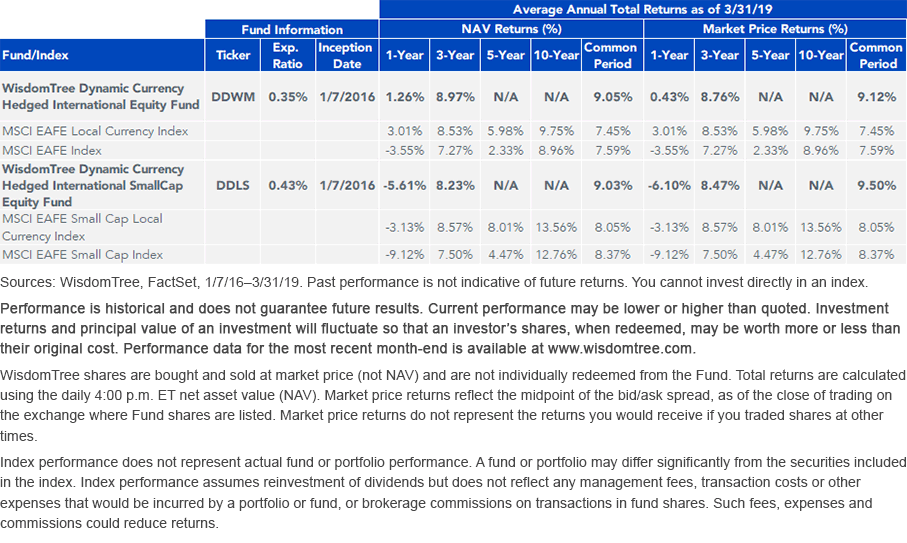The Simple Belief Behind Systematic Currency Hedging
Many investors don’t know what to make of currency fluctuations and whether they should take on currency risk or hedge it.
To help with this decision, WisdomTree launched a suite of dynamic currency hedged international equity funds in early 2016, led by our broadest international Fund, the WisdomTree Dynamic Currency Hedged International Equity Fund (DDWM).
DDWM has performed well since it launched, ranking in the 11th percentile of its Morningstar peer group since its inception and in the top 3% over the last three years.1
The small-cap version, the WisdomTree Dynamic Currency Hedged International SmallCap Equity Fund (DDLS), has performed similarly well, ranking in the 15th percentile of its peers since inception and in the 12th percentile over the last three years.2
These performance numbers are better than their unhedged WisdomTree counterparts that have more assets and longer histories, as the unhedged strategies were part of our original family that came to market in 2006.

Our View on Currency Hedging Hasn’t Changed
WisdomTree has long believed that some investors, by taking uncompensated currency bets, may take on too much risk when they invest internationally.
If you were to start with a blank sheet of paper that said:
Strategy 1: Exposure to A
Strategy 2: Exposure to A + B
With A being equal to the local equity market returns, and B, the currency return (e.g., of the euro), it should be clear that unhedged international equity strategies have exposures to two bets (A+B), and that fully hedged strategies focus on exposure to A only by hedging the traditional long bias currency exposure of unhedged strategies.
Today many investors still think of currency hedging as an exotic call and default to betting on the dollar going down forever (in other words, investors in European unhedged equities have an explicit call the euro is going to rise forever).
Of course, most investors don’t actually believe the euro will perpetually rise—they just believe currencies will “wash out in the long run.”
I recently sat down with the CEO of Record Currency Management, James Wood Collins, to discuss how investors around the world look at these directional currency bets. We discussed factors that can take an uninformed directional bet on the dollar going down forever and transform it into a systematic overlay strategy that hedges currencies based on common factors that are rewarded over time.
One of the more interesting elements of the discussion focused on interest rate carry and some unique factors today.
Carry represents how much one is paid to hedge currencies. Right now, with the current interest rate differentials around the world, one can earn almost 3% a year hedging the euro and 2.5% a year hedging the yen.
These interest rates are being collected in the forward contracts that hedge currencies global fixed income mandates that hedging currencies have similar (if not higher) yields to U.S. treasuries even though Japanese government bonds have negative yields on them nominally.
James discussed some of the unique funding elements in the supply and demand of hedging instruments that can add even more premium to forward rates than normal.
Investors often say currency hedging can be expensive and use it as a reason not to hedge. I view unhedged strategies missing a 3% euro carry pickup as expensive, and at a structural disadvantage, unless investors have a view the euro is going to rally and make up this carry loss. This is also true for broad international baskets where the average carry pickup is currently well over 2%.
This was a great discussion and we encourage you to listen to the full conversation for more information on systematic hedging strategies.
1The percentile rank is the funds’ total-return percentile rank compared to all funds within the same Morningstar category and is subject to change each month. 270 investments included in peer group for U.S. fund, foreign large value, for since inception performance, 2/1/16–3/31/19. 275 investments included in peer group for U.S. fund, foreign large value, for trailing three-years’ performance, 4/1/16–3/31/19.
2The percentile rank is the funds’ total-return percentile rank compared to all funds within the same Morningstar category and is subject to change each month. 49 investments included in peer group for U.S. fund, foreign small/mid value, for since inception performance, 2/1/16–3/31/19. 49 investments included in peer group for U.S. fund, foreign small/mid value, for trailing three-years’ performance, 4/1/16–3/31/19.
Disclaimer: Investors should carefully consider the investment objectives, risks, charges and expenses of the Funds before investing. U.S. investors only: To obtain a prospectus containing this ...
more


